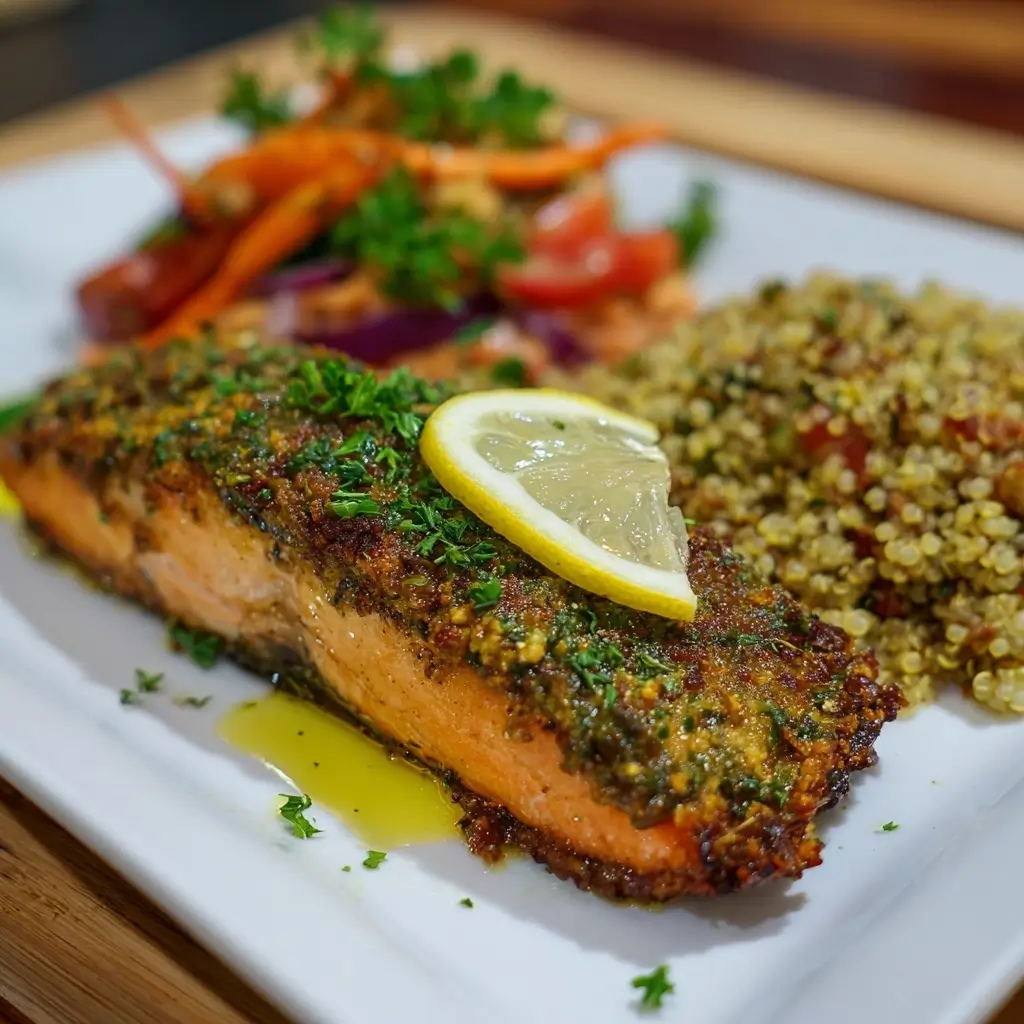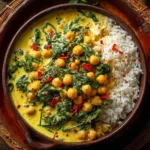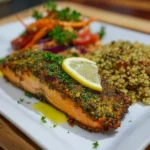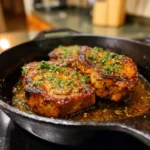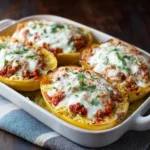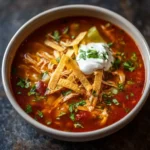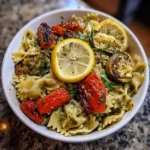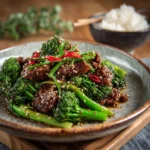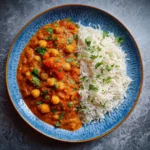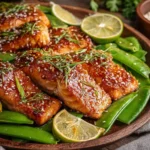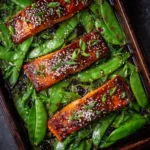Baked Herb Crusted Salmon with Quinoa Pilaf
Introduction
Welcome to a culinary journey that combines elegance, flavor, and nutrition in one harmonious dish: Baked Herb Crusted Salmon with Quinoa Pilaf. Whether you’re preparing a romantic dinner for two, hosting a family gathering, or simply treating yourself to a wholesome meal, this recipe strikes the perfect balance between gourmet appeal and home-style comfort. The succulent salmon is encrusted with a fragrant blend of fresh herbs and baked to golden perfection, while the fluffy quinoa pilaf absorbs subtle notes of garlic, lemon, and vegetables, creating a side dish that’s both hearty and healthy. With its vibrant colors, rich textures, and nourishing ingredients, this meal is as pleasing to the eye as it is to the palate.
The History
Fish has been a staple protein in coastal civilizations for thousands of years, with ancient cultures from the Mediterranean to Scandinavia perfecting techniques to prepare and preserve it. Salmon, in particular, holds a revered place in Nordic, Native American, and Pacific Northwest cuisines, where it was traditionally smoked, grilled over open flames, or baked with wild herbs. The use of herb crusts dates back to French and Italian culinary traditions, where cooks would coat meats and fish with breadcrumbs and aromatic herbs like parsley, thyme, and rosemary to enhance flavor and create a delightful texture.
Quinoa, on the other hand, hails from the Andean regions of South America, where the Inca civilization cultivated it over 5,000 years ago. Revered as “chisaya mama” or “mother of all grains,” quinoa was not only a dietary cornerstone but also held spiritual significance. It wasn’t until the late 20th century that quinoa gained global popularity due to its high protein content and gluten-free nature.
The fusion of baked herb-crusted salmon with quinoa pilaf reflects modern culinary trends—merging international ingredients with health-conscious cooking methods. This dish symbolizes the evolution of food culture: honoring tradition while embracing wellness, sustainability, and bold flavors.
Ingredients Breakdown
Understanding each ingredient helps elevate your cooking experience and ensures optimal results. Here’s a detailed look at what goes into this exquisite meal:
For the Baked Herb Crusted Salmon:
- Salmon Fillets (6 oz each): Choose center-cut fillets with even thickness for uniform cooking. Wild-caught salmon offers richer flavor and higher omega-3 content.
- Fresh Herbs (Parsley, Dill, Thyme): These provide brightness and earthiness. Parsley adds freshness, dill contributes a slight anise note, and thyme brings warmth and depth.
- Garlic (minced): A key flavor enhancer; raw garlic infuses the crust with pungency that mellows during baking.
- Lemon Zest and Juice: Adds acidity and citrus aroma, balancing the richness of the salmon.
- Olive Oil: Extra virgin olive oil binds the herb mixture and promotes browning while adding heart-healthy monounsaturated fats.
- Dijon Mustard: Acts as a base layer that helps the crust adhere and introduces tangy complexity.
- Panko Breadcrumbs: Provides a light, crispy texture without weighing down the delicate fish. For a gluten-free version, use almond flour or certified GF panko.
- Salt and Black Pepper: Essential seasonings that enhance overall flavor profile.
For the Quinoa Pilaf:
- Quinoa (uncooked): Rinsed thoroughly to remove saponins, which can impart bitterness. Use white, red, or tri-color quinoa based on preference.
- Vegetable or Chicken Broth: Enhances flavor compared to water; choose low-sodium options to control salt levels.
- Olive Oil or Butter: Adds richness and prevents sticking during cooking.
- Onion and Garlic: Sautéed as a flavor foundation (the “soffritto” of many dishes).
- Carrots and Celery: Finely diced for texture and subtle sweetness; classic mirepoix elements.
- Dried Currants or Golden Raisins: Introduce natural sweetness and chewy contrast.
- Toasted Almonds or Pine Nuts: Add crunch and nutty flavor, boosting satiety and healthy fats.
- Lemon Juice and Fresh Herbs (parsley, chives): Brighten the pilaf and complement the salmon.
- Spices (ground cumin, cinnamon – optional): Warm spices deepen flavor complexity subtly.
Step-by-Step Recipe
Preparing the Quinoa Pilaf
- Rinse 1 cup of quinoa under cold running water using a fine-mesh strainer for at least 30 seconds to remove any residual saponin.
- In a medium saucepan, heat 1 tablespoon of olive oil over medium heat. Add ½ cup finely diced yellow onion and sauté for 3–4 minutes until translucent.
- Add 1 minced garlic clove, ¼ cup finely diced carrots, and ¼ cup diced celery. Cook for another 4–5 minutes until vegetables soften slightly.
- Stir in the rinsed quinoa and toast for 1 minute to enhance nuttiness.
- Pour in 2 cups of warm vegetable or chicken broth. Add a pinch of salt, a dash of black pepper, and optionally ¼ teaspoon ground cumin or a tiny pinch of cinnamon.
- Bring to a boil, then reduce heat to low, cover, and simmer for 15 minutes or until liquid is absorbed and quinoa is fluffy with visible spiral tails.
- Remove from heat and let sit covered for 5 minutes. Fluff with a fork.
- Stir in 2 tablespoons of fresh chopped parsley, 1 tablespoon of snipped chives, juice of half a lemon, and 2 tablespoons of toasted sliced almonds or pine nuts. Taste and adjust seasoning.
- Cover and keep warm while preparing the salmon.
Preparing the Baked Herb Crusted Salmon
- Preheat oven to 400°F (200°C). Line a baking sheet with parchment paper or lightly grease with olive oil.
- Pat 4 salmon fillets dry with paper towels to ensure proper crust adherence.
- Season each fillet lightly with salt and pepper on both sides.
- In a small bowl, mix 1 tablespoon Dijon mustard with 1 teaspoon lemon juice. Evenly spread this mixture over the top of each salmon fillet.
- In a separate bowl, combine ⅓ cup panko breadcrumbs, 2 tablespoons each of finely chopped fresh parsley and dill, 1 tablespoon chopped fresh thyme, 1 minced garlic clove, 1 teaspoon lemon zest, 1 tablespoon olive oil, and a pinch of salt and pepper.
- Sprinkle the herb mixture generously over the mustard-coated side of each fillet, pressing gently to adhere.
- Place fillets on the prepared baking sheet, crust-side up. Drizzle lightly with a touch more olive oil if desired.
- Bake for 12–15 minutes, depending on thickness. The salmon should flake easily with a fork and reach an internal temperature of 145°F (63°C). Avoid overcooking to retain moisture.
- Optional: Broil for the last 1–2 minutes to deepen the crust color, watching closely to prevent burning.
- Let rest for 2–3 minutes before serving.
Tips
- Uniform Fillets: Select salmon fillets of similar size and thickness for even cooking.
- Dry Fish Surface: Always pat salmon dry before applying the mustard layer—this helps the crust stick better.
- Fresh Herbs Matter: While dried herbs can be substituted in a pinch, fresh ones deliver superior flavor and vibrancy.
- Toast Your Breadcrumbs: For extra depth, lightly toast panko in a dry pan before mixing with herbs.
- Don’t Skip Resting: Letting the salmon rest after baking allows juices to redistribute, resulting in a moister bite.
- Use a Meat Thermometer: Ensures precision and prevents overcooking—especially important with thicker cuts.
- Make Ahead Components: Quinoa pilaf can be made up to a day ahead and reheated gently with a splash of broth.
- Double the Crust: If you love texture, increase the herb-panko mixture by 50% for a thicker crust.
- Line the Pan: Parchment paper or foil makes cleanup effortless and prevents sticking.
Variations and Customizations
This recipe is highly adaptable to suit different tastes, dietary needs, and seasonal ingredients:
- Gluten-Free Option: Replace panko with gluten-free breadcrumbs or crushed cornflakes. Alternatively, use almond meal or crushed pork rinds for a keto-friendly version.
- Dairy-Free/Vegan Twist: Omit butter from the pilaf and use olive oil. Serve the herb crust without cheese additions (if used) and pair with plant-based protein alternatives when needed.
- Spicy Kick: Add ¼ teaspoon smoked paprika or a pinch of cayenne to the herb crust. Include diced jalapeño in the pilaf for heat.
- Mediterranean Style: Mix crumbled feta, sun-dried tomatoes, and Kalamata olives into the quinoa. Top salmon with oregano instead of dill.
- Asian Fusion: Swap herbs for ginger, scallions, and cilantro. Use sesame oil and soy sauce in the pilaf. Glaze salmon with miso paste before coating.
- Nut-Free Version: Skip almonds or pine nuts in the pilaf; substitute with roasted pumpkin seeds (pepitas).
- Herb Swaps: Basil, tarragon, or chervil can replace dill or thyme for unique flavor profiles.
- Citrus Variations: Try orange zest instead of lemon, or add grapefruit segments to the finished pilaf.
- Cheesy Crust: Mix grated Parmesan into the breadcrumb mixture for a savory umami boost.
- Smoked Salmon Option: Use smoked salmon flakes in the pilaf for a brunch-inspired twist.
Health Considerations and Nutritional Value
This dish shines not only in taste but also in nutritional excellence. Let’s break down its health benefits:
Salmon Benefits:
- Omega-3 Fatty Acids (EPA & DHA): Support heart health, reduce inflammation, and promote brain function.
- High-Quality Protein: Essential for muscle repair, immune support, and satiety.
- Vitamin D: Rare in foods, vital for bone health and immune regulation.
- B Vitamins (B12, Niacin, B6): Aid energy metabolism and nervous system function.
Quinoa Benefits:
- Complete Protein: Contains all nine essential amino acids—rare among plant-based foods.
- Fiber-Rich: Promotes digestive health and helps regulate blood sugar.
- Gluten-Free: Safe for individuals with celiac disease or gluten sensitivity.
- Minerals Galore: High in magnesium, iron, phosphorus, and manganese.
Nutritional Profile (Per Serving – Approximate):
| Nutrient | Amount |
|---|---|
| Calories | ~480 kcal |
| Protein | 34g |
| Total Fat | 26g |
| Saturated Fat | 4g |
| Monounsaturated Fat | 12g |
| Polyunsaturated Fat (incl. Omega-3) | 7g |
| Carbohydrates | 28g |
| Dietary Fiber | 5g |
| Sugars | 6g (mostly natural from currants/raisins) |
| Sodium | ~450mg (adjustable based on broth and added salt) |
| Vitamin D | 20% DV |
| Vitamin B12 | 100%+ DV |
| Iron | 15% DV |
| Magnesium | 20% DV |
Note: Values may vary based on specific ingredients and portion sizes. Using low-sodium broth and limiting added salt enhances cardiovascular friendliness.
Dietary Suitability: Naturally dairy-free (if oil is used), can be made gluten-free, paleo (with grain substitution), Whole30-compliant (with approved modifications), and pescatarian-friendly.
Ingredients
Baked Herb Crusted Salmon (Serves 4):
- 4 (6 oz) skin-on or skinless salmon fillets
- 1 tablespoon Dijon mustard
- 1 teaspoon fresh lemon juice
- ⅓ cup panko breadcrumbs (or gluten-free alternative)
- 2 tablespoons fresh parsley, finely chopped
- 2 tablespoons fresh dill, finely chopped
- 1 tablespoon fresh thyme leaves
- 1 garlic clove, minced
- 1 teaspoon lemon zest
- 1 tablespoon extra virgin olive oil
- Salt and freshly ground black pepper to taste
- 1 teaspoon olive oil (for drizzling)
Quinoa Pilaf (Serves 4):
- 1 cup uncooked quinoa, rinsed well
- 2 cups low-sodium vegetable or chicken broth
- 1 tablespoon olive oil or butter
- ½ cup yellow onion, finely diced
- 1 garlic clove, minced
- ¼ cup carrots, finely diced
- ¼ cup celery, finely diced
- 2 tablespoons dried currants or golden raisins
- 2 tablespoons sliced almonds or pine nuts, toasted
- Juice of ½ lemon
- 2 tablespoons fresh parsley, chopped
- 1 tablespoon fresh chives, snipped
- ¼ tsp ground cumin (optional)
- Salt and pepper to taste
Directions
- Preheat Oven: Set oven to 400°F (200°C). Prepare a baking sheet with parchment paper.
- Cook Quinoa Pilaf Base: In a saucepan, heat olive oil over medium heat. Add onion, carrot, and celery; cook 5–6 minutes until soft. Stir in garlic and cook 30 seconds.
- Toast Quinoa: Add rinsed quinoa to the pot and stir for 1 minute to toast slightly.
- Simmer: Pour in warm broth, add salt, pepper, and cumin (if using). Bring to a boil, then reduce heat to low, cover, and simmer 15 minutes. Remove from heat; let stand 5 minutes, then fluff with a fork.
- Finish Pilaf: Stir in lemon juice, parsley, chives, currants, and toasted almonds. Adjust seasoning. Keep warm.
- Prepare Salmon: Pat fillets dry. Season with salt and pepper. Mix Dijon and lemon juice; spread thinly over top of each fillet.
- Make Herb Crust: In a bowl, combine panko, parsley, dill, thyme, garlic, lemon zest, olive oil, salt, and pepper.
- Coat Salmon: Press herb mixture onto the mustard-covered side of each fillet.
- Bake: Place fillets crust-side up on baking sheet. Drizzle with a little oil. Bake 12–15 minutes until salmon is opaque and flakes easily.
- Optional Broil: Switch to broil for 1–2 minutes for a deeper golden crust.
- Rest and Serve: Let salmon rest 2–3 minutes. Serve atop or alongside quinoa pilaf.
FAQ
- Can I use frozen salmon?
- Yes, but thaw it completely in the refrigerator overnight. Pat very dry before seasoning to avoid excess moisture.
- How do I know when salmon is done?
- It should be opaque throughout and flake easily with a fork. Internal temperature should read 145°F (63°C).
- Can I make this ahead of time?
- You can prep the quinoa pilaf and herb mixture a day ahead. Assemble and bake salmon just before serving for best texture.
- What can I substitute for quinoa?
- Couscous, brown rice, farro, or cauliflower rice work well depending on dietary preferences.
- Is the skin edible?
- Absolutely! When baked, salmon skin becomes crispy and delicious. You can leave it on or ask your fishmonger to remove it.
- Can I grill instead of bake?
- Yes! Grill over medium heat (about 375°F) for 6–8 minutes per side. Use a grilling plank or foil to prevent sticking.
- Why did my crust fall off?
- Likely causes: wet fish surface, insufficient binder (mustard), or disturbance during baking. Ensure fish is dry and press crust firmly.
- Can I double the recipe?
- Easily! Just use two baking sheets or rotate pans halfway through for even cooking.
- Are there sustainability concerns with salmon?
- Yes. Opt for wild-caught Alaskan salmon or responsibly farmed varieties (look for MSC or Aquaculture Stewardship Council certifications).
- Can I freeze leftovers?
- Cooked salmon freezes well for up to 2 months. Quinoa pilaf also freezes nicely. Reheat gently with a splash of broth or water.
Summary
Baked Herb Crusted Salmon with Quinoa Pilaf is a restaurant-quality meal that’s simple enough for weeknights yet elegant enough for special occasions. Packed with flavor, texture, and essential nutrients, it celebrates the harmony of land and sea on a single plate.
This versatile, health-forward dish supports balanced eating while delighting the senses—making it a timeless addition to your culinary repertoire.
